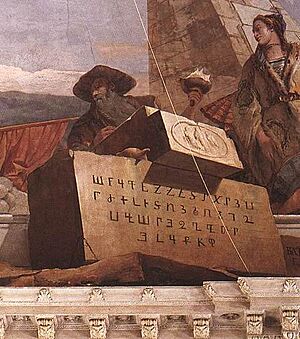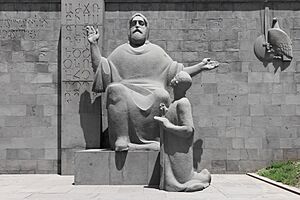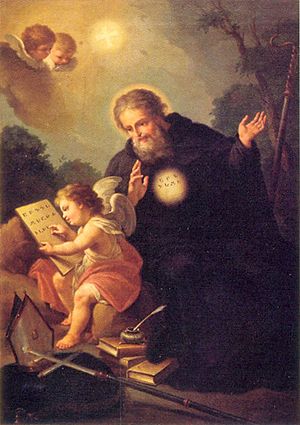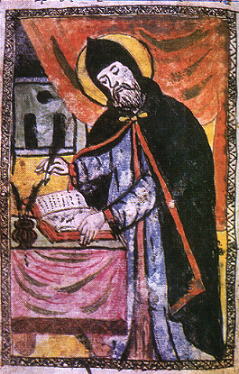Mesrop Mashtots facts for kids
Quick facts for kids SaintMesrop Mashtots |
|
|---|---|

Portrait of Mashtots by Stepanos Nersissian (1882)
|
|
| Born | c. 362 Hatsik, Taron Province, Kingdom of Armenia (Now Güven village of Korkut, Muş Province, Turkey) |
| Died | February 17, 440 Vagharshapat, Sasanian Armenia |
| Venerated in | Armenian Apostolic Church Armenian Catholic Church Roman Catholic Church Eastern Orthodox Church |
| Major shrine | Saint Mesrop Mashtots Cathedral in Oshakan, Armenia |
| Feast | The Armenian Church remembers St. Mesrop (together with St. Sahak), twice each year, first in July and then again on the Feast of the Holy Translators in October; February 17 in the Roman Catholic Church. |
| Patronage | Armenia |
Mesrop Mashtots (born around 362 AD, died February 17, 440 AD) was an important Armenian figure from the early Middle Ages. He was a linguist, composer, and a religious leader. He is most famous for inventing the Armenian alphabet around 405 AD. This invention was a huge step in making Armenians feel like a strong, unique nation.
Many people also believe he helped create the Caucasian Albanian and Georgian alphabets. He is honored as a saint in the Armenian Apostolic Church, the Armenian Catholic Church, and the Roman Catholic and Eastern Orthodox churches.
Contents
Life and Achievements

Mesrop Mashtots was born into a noble family in a village called Hatsekats, in the Taron region of Armenia. His father's name was Vardan. His student, Koryun, wrote about Mesrop's life. Koryun said that Mesrop had a good education and knew both Greek and Persian languages very well.
Because he was so smart and religious, Mesrop became a secretary for King Khosrov IV. His job was to write down the king's official messages and laws in Persian and Greek. Later, he decided to leave the royal court and became a monk. He lived a very strict and religious life for several years.
In 387 AD, Armenia lost its independence. The country was split between the Byzantine Empire and Persia. Most of Armenia became part of Persia. During this time, three important people worked together to help Armenia: Mesrop, the religious leader Catholicos Isaac, and King Vramshapuh.
Creating the Armenian Alphabet
In 394 AD, Mesrop began a mission to spread the Christian faith. He traveled to different areas, teaching the Gospel and converting many people.
At that time, Armenians did not have their own alphabet. They used Greek, Persian, and Syriac letters. But these alphabets did not have all the sounds needed for the Armenian language. This made it hard for people to understand the Bible and church services. Translators had to explain everything.
Mesrop, Catholicos Isaac, and King Vramshapuh realized how important it was for Armenians to have their own writing system. Mesrop worked hard to create a new alphabet. He talked to wise people like Bishop Daniel and a monk named Rufinus.
Around 405 AD, Mesrop invented an alphabet with thirty-six letters. Later, two more letters were added. The very first sentence written in the new Armenian alphabet was from the Book of Proverbs in the Bible:
Ճանաչել զիմաստութիւն եւ զխրատ, իմանալ զբանս հանճարոյ:
Čanačʿel zimastutʿiwn ew zxrat, imanal zbans hančaroy. «To know wisdom and instruction; to perceive the words of understanding.»
The invention of the Armenian alphabet was a huge moment. It marked the start of Armenian literature. It also helped Armenians feel more united and proud of their unique culture. Many historians believe that without Mesrop's work, the Armenian language and people might have been lost.
Some old Armenian writings also say that Mashtots created the Georgian and Caucasian Albanian alphabets around the same time. Many experts agree that the Georgian alphabet was likely created when Georgia became Christian, around the same period as the Armenian alphabet.
Spreading Education
With the support of the church leader and the king, Mesrop opened many schools across the country. Young people learned the new alphabet in these schools. He even taught at the Amaras Monastery in the Armenian region of Artsakh.
Mesrop's work wasn't just in Eastern Armenia. He traveled to Constantinople (modern-day Istanbul) and got permission from the emperor to teach in Armenian areas controlled by the Byzantine Empire.
After returning to Armenia, he focused on providing religious books for his people. He sent his students to famous learning centers like Edessa, Athens, and Alexandria. They went to study Greek and bring back important Greek books. Some of his most famous students were Koryun and Moses of Chorene.
Translating the Bible
One of the first big projects was translating the Bible into Armenian. Catholicos Isaac started translating the Bible from Syriac around 411 AD. However, this translation was not perfect. So, some of Mesrop's students were sent to get better copies of the Greek Bible.
With these copies, the Bible was translated again from Greek. This new version, which is still used in the Armenian Church today, was finished around 434 AD.
Important church rules and services were also translated into Armenian. Many works by early Christian writers were translated too. Some of these Armenian translations are very important because the original Greek versions have been lost.
Mesrop continued to visit the areas where he had taught Christianity earlier in his life. After Catholicos Isaac died in 439 AD, Mesrop helped manage the church. He passed away just six months after his friend and teacher.
Saint Mesrop Mashtots is buried in a chapel in the village of Oshakan, Armenia. The Roman Catholic Church celebrates his feast day on February 17.
Legacy and Influence

Mesrop Mashtots is a national hero in Armenia. Almost every town in Armenia has a street named after him. In the capital city, Yerevan, one of the most important streets is Mashtots Avenue.
There are statues of him in several places:
- At the Matenadaran, a famous library of ancient manuscripts in Yerevan.
- At the church where he is buried in Oshakan village.
- At a monument dedicated to the Armenian alphabet near Mount Aragats.
Both the Soviet Union and modern Armenia have issued stamps with his image.
The Order of St. Mesrop Mashtots is a special award in Armenia. It was created in 1993. This award is given to people who have made big achievements in Armenia's economy, science, culture, education, or public service.
Music Compositions
Besides his work with languages, Mesrop Mashtots also wrote several religious songs. Some of the hymns believed to be his include:
- «Մեղայ քեզ Տէր» (Meġay k’ez Tēr, meaning “I have sinned against you, Lord”)
- «Ողորմեա ինձ Աստուած» (Voġormea inj Astuac, meaning “Have mercy on me, God”)
- «Անկանիմ առաջի քո» (Ankanim aṙaǰi k’o, meaning “I kneel before you”)
- «Ողորմեա» (Voġormea, meaning “Miserere” or “Have mercy”)
These songs are all about asking for forgiveness.
Documentary Films
- Mashtots (1988), directed by Levon Mkrtchyan
See also
- Bible translations
- In Spanish: Mesrob Mashtots para niños






